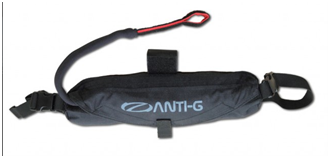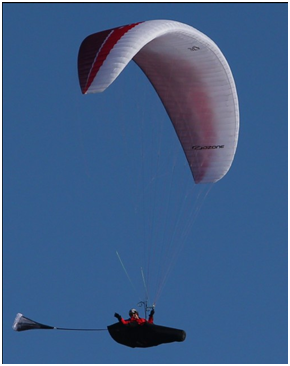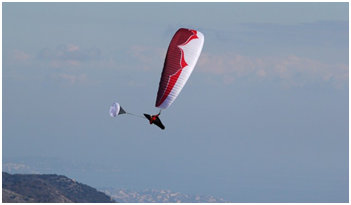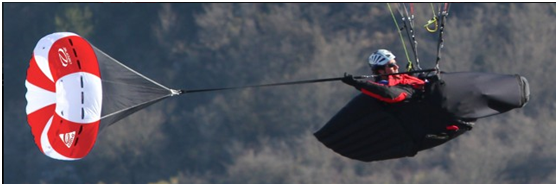OZONE THE ANTI-G
- ¥900
原价:¥0
THE ANTI-G
Have you ever blacked out during a steep spiral dive before? Or, have younever had the courage to spiral so steeply? Well, whatever make of wing youfly, regardless of whether you have been spiralling too hard or not hardenough, the Anti-G will change your life – for the better. The Anti-G is asafety device that allows safer spiral descents by reducing G Force in a spiraldive. It is simple and easy to use, and is particularly effective for higheraspect ratio wings.
· Intended primarily for use by competitionpilots and pilots of high aspect ratio wings
· The Anti-G is simple to use, but must beused only as directed. You must read and understand the user manual prior touse in flight.
· The Anti-G packs into a pouch that issmaller than an average cockpit.It can be used with any harness.
· Lightweight and compact: 620 grams total.
The Anti-G is fixed to the main attachment point of your harness on theside that you wish to spiral toward. Just deploy the chute, and begin yourspiral dive as normal. Although you will be able to enter a steep spiral dive,you will make fewer turns while maintaining a higher sink rate and experiencingfar less G-Force. Most pilots will experience a massive 40% reduction inG-Force while using the Anti-G. Using the Anti-G will allow you to reach ahigher sink rate in your spiral with greater situational awareness due todecreased G-Force. Also, the reduction in G-Force means less strain on yourwing and lines. With the Anti-G deployed in level flight, you will not feel asignificant disturbance or yaw force on your harness at trim speed*.
You may descend in spiral and land as normal with the chute deployed. TheAnti-G features a “kill line” to disable it easily in flight. We highlyrecommend this tool for all competition pilots whatever make of wing they fly;due to the high efficiency of some wings (like the Mantra and Mantra R series),it is difficult to descend effectively in spiral dive without excessiveG-Force. The Anti-G allows for a very steep descent rate at low Gs for all brandsof wings. If you are ordering an R11 then it is a good idea to order an Anti-G,too.
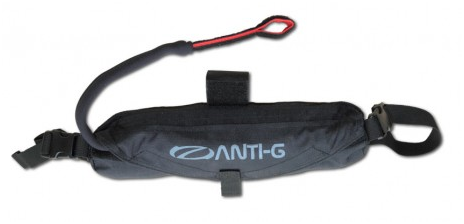
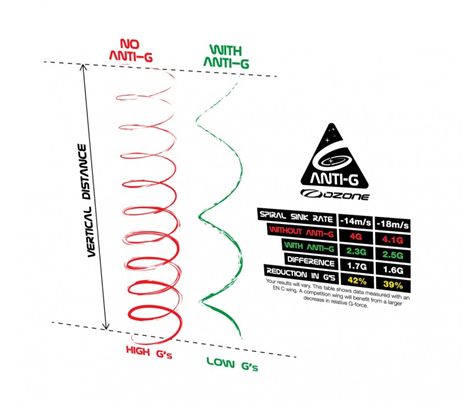
*The Anti-G is not to be used as a tool to land in a shorter than normaldistance, it is intended only for use as a tool to decrease G-Force in aspiral.
Why is the Anti-G attached asymmetrically (on one side only)?
The Anti-G is attached toonly one side so that it can be used with any type of harness. Also, it isdesigned for use in a spiral which is an asymmetric manouvre to begin with.During the spiral, the Anti-G is attached to the inside riser.
Withthe Anti-G deployed, is my wing closer to stall, collapse, or spin?
Because the Anti-G isattached to the carabiner, it is very close to the center of gravity of yoursystem (wing + pilot). Therefore, it does not influence the pitch stability ofyour wing. To prove that point - if the Anti-G were positioned higher, forinstance mid-way up your lines, it would exert a rearward force on the glider,giving it a stall tendency.
We could say that thewing doesn’t “feel” your Anti-G, it is only your glide ration which suffers;the Anti-G does not change your pitch equilibrium. The same logic applies whilein spiral, and the Anti-G does not cause any spin tendency.
However, the Anti-G doesadd a very slight yaw asymmetry at trim speed, and a more noticeable asymmetryin accelerated flight.
Doesmy wing have the same behavior in spiral with the Anti-G?
Yes, all of our testinghas shown that a wing’s behavior in spiral (stable or instable) does not changewith the Anti-G added.
Whatabout the Anti-G in straight and level flight?
The Anti-G serves nopurpose in straight flight. With only 1.2m of surface area, it is too small tocreate significant drag at trim speed. For instance, it would not help you toland in a shorter distance – for such an application, the Anti-G is far lesseffective than the appropriate use of your brakes.
During a spiral, theAnti-G’s effectiveness is multiplied by a factor of 10 due to the increase inairspeed and the fact that drag is proportionate to speed. We do not recommendusing the Anti-G as a landing approach tool, in addition to it beingineffective, it may also disturb your standard approach patterns.
Canthe Anti-G be retracted and re-used in flight?
While it is possible toreuse the Anti-G multiple times during a flight, Ozone does not recommend it.If the pilot retracts the Anti-G in flight, there is a danger of suddenre-inflation in the relative airflow. If the Anti-G re-inflates close to thepilot, it may cause the parachute to obscure the pilot’s view or reduce thepilot’s capability to control his/her wing. We recommend that pilots use theAnti-G for one descent only, then disable it with the kill-line before landing.Each pilot must make his or her own decision as to what is safe and comfortablefor them in each situation. You are responsible.
Can the Anti-G benefit the lifespan of my equipment?
Yes, because it greatlyreduces the amount of G-Force. The number of Gs is directly proportional to thestress applied to the structure of your wing. Your wing suffers less loadingwhen spiraled with the Anti-G.
What purpose does theshrink tab on the inside of the container serve?
This helps to keep thered stuff sack on the interior of the container in order to prevent it frominflating in the relative wind during flight and disturbing the pilot.
Thecontainer is too small!
Your Anti-G spends moretime folded in your harness than it does inflated behind you, and for thisreason it should take up the least amount of space possible in your harness.The container is designed to receive a properly folded Anti-G. Read the manual,and after one or two practice folds you will realize that it is very easy toput the Anti-G back into its container.
Whatside do I attach it to?
· The inside of the spiral turn(spiraling left, attach it left side, and vice versa).
· The side opposite to yourreserve parachute (in case of the unlikely event that you would need to deployyour reserve while the Anti-G is in use).
My Harness has a “drag chute” attachment point on theshoulder. Should I use that for the Anti-G?
No. We recommend that youattach the Anti-G to your carabiner as shown in the user manual only.
I tried to pull my Anti-G back on board and it re-inflatedwhile I was trying to pull it in!
First of all, we don’trecommend that you do this. If you find yourself in a situation where it ismandatory to retrieve the Anti-G and store it for redeployment, then hold thewebbing (bridle) firmly and if necessary kink it a little with your fingers toprevent the apex kill line from sliding inside the webbing.
While itis possible to reuse the Anti-G multiple times during a flight, Ozone does notrecommend it. If the pilot retracts the Anti-G in flight, there is a danger ofsudden re-inflation in the relative airflow. If the Anti-G re-inflates close tothe pilot, it may cause the parachute to obscure the pilot’s view or reduce thepilot’s capability to control his/her wing. We recommend that pilots use theAnti-G for one descent only, then disable it with the kill-line before landing.
